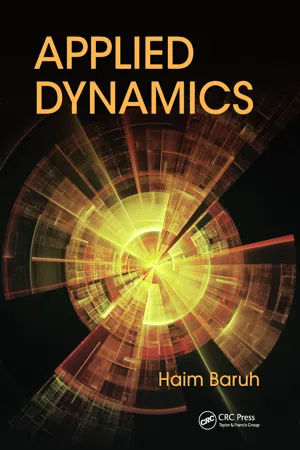Physics
Angular Kinematic Equations
Angular kinematic equations are used to describe the rotational motion of an object. They relate angular displacement, angular velocity, and angular acceleration. The three main equations are: ωf = ωi + αt, θ = ωit + 0.5αt^2, and ωf^2 = ωi^2 + 2αθ, where ω represents angular velocity, θ is angular displacement, α is angular acceleration, t is time, and the subscripts i and f denote initial and final values.
Written by Perlego with AI-assistance
Related key terms
1 of 5
7 Key excerpts on "Angular Kinematic Equations"
- eBook - PDF
- John D. Cutnell, Kenneth W. Johnson, David Young, Shane Stadler, Heath Jones, Matthew Collins, John Daicopoulos, Boris Blankleider(Authors)
- 2020(Publication Date)
- Wiley(Publisher)
CHAPTER 8 Rotational kinematics LEARNING OBJECTIVES After reading this module, you should be able to: 8.1 define angular displacement 8.2 define angular velocity and angular acceleration 8.3 solve rotational kinematics problems 8.4 relate angular and tangential variables 8.5 distinguish between centripetal and tangential accelerations 8.6 analyse rolling motion 8.7 use the right‐hand rule to determine the direction of angular vectors. INTRODUCTION The figure shows the front view of a turbine jet engine on a commercial aircraft. The rotating fan blades collect air into the engine before it is compressed, mixed with fuel, and ignited to produce thrust. The rotational motion of the blades can be described using the concepts of angular displacement, angular velocity, and angular acceleration within the framework of rotational kinematics. Source: Mikhail Starodubov / Shutterstock 8.1 Rotational motion and angular displacement LEARNING OBJECTIVE 8.1 Define angular displacement. FIGURE 8.1 When a rigid object rotates, points on the object, such as A, B, or C, move on circular paths. The centres of the circles form a line that is the axis of rotation. A B C Axis of rotation In the simplest kind of rotation, points on a rigid object move on circular paths. In figure 8.1, for example, we see the circular paths for points A, B, and C on a spinning skater. The centres of all such circular paths define a line, called the axis of rotation. The angle through which a rigid object rotates about a fixed axis is called the angular displacement. Figure 8.2 shows how the angular displacement is measured for a rotating compact disc (CD). Here, the axis of rotation passes through the centre of the disc and is perpendicular to its surface. On the surface of the CD we draw a radial line, which is a line that intersects the axis of rotation perpendicularly. As the CD turns, we observe the angle through which this line moves relative to a convenient reference line that does not rotate. - eBook - PDF
- Richard C. Hill, Kirstie Plantenberg(Authors)
- 2013(Publication Date)
- SDC Publications(Publisher)
Conceptual Dynamics Kinematics: Chapter 4 – Kinematics of Rigid Bodies 4 - 6 idea to convert non-radian units into radians before performing calculations to avoid errors due to unit mismatch. Angular speed: d dt (4.2-1) Angular acceleration: d dt (4.2-2) d d (4.2-3) = angular displacement (rad) = angular speed (rad/s) = angular acceleration (rad/s 2 ) t = time Even though Equations 4.2-1 through 4.2-3 are not written as such, angular displacement, angular velocity and angular acceleration are vector quantities. Specifically, all of the angular motion parameters have a magnitude and direction of rotation. A simplified way of looking at this is that the rotational direction can be clockwise or counterclockwise. This clockwise/counterclockwise direction can be expressed as a negative or positive sign attached to the magnitude. For more complex systems, the rotational direction is expressed with unit direction vectors, usually k for a planar motion (i.e. 2-D) system, or as a combination of unit direction vectors for motion in three dimensions. Whether you indicate the direction as being clockwise or counterclockwise, or with unit direction vectors such as k, these quantities have both magnitude and direction making them vectors. An easy way to determine the direction of angular motion and whether it is positive or negative is through the use of the right-hand rule. Here's how it works: take the fingers on your right hand and curl them in the direction of rotation. The direction of the vector representing the angular motion is indicated by the direction of your thumb. For example, if your thumb is pointing along the positive y-axis, the direction is j. If your thumb is pointing along the negative x-axis it is -i. For planar problems, clockwise motion corresponds to a vector pointing in to the paper and counterclockwise motion corresponds to a vector pointing out of the paper (as in Figure 4.2-1). - eBook - PDF
- John D. Cutnell, Kenneth W. Johnson, David Young, Shane Stadler(Authors)
- 2015(Publication Date)
- Wiley(Publisher)
These equations, like those developed in Chapters 2 and 3 for linear motion, will prove very useful in solving problems that involve rotational motion. A complete description of rotational motion requires values for the angular displace- ment Du, the angular acceleration a, the final angular velocity v, the initial angular velocity v 0 , and the elapsed time Dt. In Example 4, for instance, only the angular displacement of the fan blades during the 14-s interval is missing. Such missing information can be cal- culated, however. For convenience in the calculations, we assume that the orientation of the rotating object is given by u 0 5 0 rad at time t 0 5 0 s. Then, the angular displacement becomes Du 5 u 2 u 0 5 u, and the time interval becomes Dt 5 t 2 t 0 5 t. In Example 4, the angular velocity of the fan blades changes at a constant rate from an initial value of v 0 5 2110 rad/s to a final value of v 5 2330 rad/s. Therefore, the average angular velocity is midway between the initial and final values: v 5 1 2 [(2110 rad/s) 1 (2330 rad/s)] 5 2220 rad/s In other words, when the angular acceleration is constant, the average angular velocity is given by v 5 1 2 (v 0 1 v) (8.5) With a value for the average angular velocity, Equation 8.2 can be used to obtain the angu- lar displacement of the fan blades: u 5 v t 5 (2220 rad/s)(14 s) 5 23100 rad In general, when the angular acceleration is constant, the angular displacement can be obtained from u 5 v t 5 1 2 (v 0 1 v)t (8.6) This equation and Equation 8.4 provide a complete description of rotational motion under the condition of constant angular acceleration. Equation 8.4 (with t 0 5 0 s) and Equation 8.6 are compared with the analogous results for linear motion in the first two rows of Table 8.1. 8.3 | The Equations of Rotational Kinematics 179 - eBook - PDF
- Haim Baruh(Author)
- 2014(Publication Date)
- CRC Press(Publisher)
2 Kinematics Fundamentals 2.1 Introduction This chapter discusses the kinematics of motion, that is, looking at the nature of the motion without examining the forces that cause the motion. We will focus on the two-and three-dimensional kinematics of particles, as well as planar kinematics of rigid bodies. Three-dimensional kinematics of rigid bodies will be discussed in Chapter 9. We begin with coordinate systems and the kinematics of particles. The motion of par-ticles is purely translational. Then, rotating reference frames, rotation parameters, angular velocity, and angular acceleration are discussed. Relative velocity and acceleration equations are developed. Instant centers are introduced, as they are crucial to the analysis of vehicles and mechanisms. Kinematic analysis serves two purposes: First and foremost, it is a precursor to kinetic analysis, a topic that will be discussed in the next chapter. We cannot analyze the kinetics of a system without first studying its kinematics. In addition, kinematic analysis by itself is a valuable tool and is widely used in the design of mechanisms and vehicle suspensions, as well as in motion planning. Chapter 3 discusses applications of kinematics. 2.2 Position, Velocity, and Acceleration When studying the kinematics of a particle, that is, the translational motion of a point, we need to describe its position, velocity, and acceleration. The description must be made with respect to a reference point or origin using a coordinate system . A coordinate system or coordinate frame is characterized by a set of coordinate axes, the positive directions of these axes, and unit vectors along these axes. Several types of coordinate systems exist. We select the coordinate system (or frame) that will make the analysis easier and more meaningful. Selecting a coordinate frame is, in essence, selecting the set of motion variables. - eBook - PDF
- John Matolyak, Ajawad Haija(Authors)
- 2013(Publication Date)
- CRC Press(Publisher)
139 © 2010 Taylor & Francis Group, LLC Rotational Motion Translational motion and circular motion, uniform and nonuniform of an object, were discussed in Chapters 3 and 4. In this chapter, rotational motion of a point or extended object will be introduced. A force acting on an extended object creates a torque that rotates it about a fixed axis. A solid object of finite physical size is known as a rigid body. The axis of rotation could be about the center of mass of the rigid body or about other points where it is pivoted. In this chapter, Sections 8.2 through 8.7 discuss the kinematics of a rigid body, and Section 8.8 reviews the dynamics of the rigid body. In addition to drawing a parallel between Newton’s laws applied to point-like objects in linear motions and those applied to rotational motion of a rigid body, translational and rotational motions of a rigid body are discussed in detail. 8.1 ANGULAR KINEMATIC QUANTITIES Consider a point-like object moving in a circle of radius r (Figure 8.1). As the object moves from point P 1 at t 1 to point P 2 at t 2 , it sweeps through an arc Δ s that subtends an angle Δθ ( = θ 2 – θ 1 ) at the center, in a time interval Δ t = t 2 – t 1 . From geometry Δ s = r Δθ , (8.1) where Δθ is an angular displacement, measured in radians. To convert an angle expressed in degrees to radians, the following relation may be used: θ π θ rad deg deg 2 rad 360 = , (8.2a) and from radians to degrees, the conversion is θ π θ de g r ad 360 2 . = (8.2b) Dividing Equation 8.1 by Δ t gives the average linear velocity v ; that is, ∆ ∆ ∆ ∆ s t r t = θ or v r . = ω (8.3) For an object experiencing a constant linear acceleration, v v v 2 1 2 = + . 8 140 Essential Physics © 2010 Taylor & Francis Group, LLC Here, v 1 and v 2 are the instantaneous tangential, or linear, velocities of the object at points P 1 and P 2 , respectively. - eBook - PDF
- Patrick Hamill(Author)
- 2022(Publication Date)
- Cambridge University Press(Publisher)
The linear velocity v of any particle is related to the angular velocity of the body, ω, according to v = ωr , where r is the distance from the axis of rotation to the particle. The kinetic energy of the particle is T = 1 2 mv 2 = 1 2 m(ωr) 2 and the total rotational kinetic energy is T = i 1 2 m i r 2 i ω 2 . The quantity ∑ i m i r 2 i is the moment of inertia of the body, I . 5 Therefore the rotational kinetic energy can be expressed as T = 1 2 Iω 2 . (1.18) Note the similarity to the translational kinetic energy T = 1 2 mv 2 . Exercise 1.10 A disk of mass M and radius R is initially at rest. It is acted upon by a constant torque N for a time T . Determine the final angular velocity of the disk and the work required to spin it up to this final state. If the energy was supplied by a motor, what was the average power output of the motor? Answer: Average power = N 2 T /MR 2 . 1.8 Angular Momentum The angular momentum of a particle with linear momentum p is defined to be l = r × p. The direction of l is perpendicular to both r and p, as given by the right-hand rule. The magnitude of the angular momentum, from the rule for cross products is l = |l| = |r × p| = |r×mv| = rmv sin θ, where θ is the angle between the vectors r and v. For an extended rigid body, the total angular momentum is L = l i = (r i × p i ). The relationship between the net external torque acting on a body and the rate of change of the angular momentum of the body is N net = d L dt . (I don’t want to prove this now; the proof is a bit long and is found in Section 7.3.) If the net torque acting on a system is zero, the angular momentum of the system is constant. This is called the law of conservation of angular momentum. 5 In Section 7.5 we will define the moment of inertia more generally and in Chapter 17 we introduce the inertia tensor. - No longer available |Learn more
Physics for Scientists and Engineers
Foundations and Connections, Extended Version with Modern Physics
- Debora Katz(Author)
- 2016(Publication Date)
- Cengage Learning EMEA(Publisher)
Copyright 2017 Cengage Learning. All Rights Reserved. May not be copied, scanned, or duplicated, in whole or in part. WCN 02-300 338 CHAPTER 12 Rotation I: Kinematics and Dynamics 12-3 Special Case of Constant Angular Acceleration In one-dimensional translational kinematics (Chapter 2), we considered the special case in which a particle moves with constant acceleration. The special case of a u 5 constant for translational motion is analogous to the special case of a u 5 constant for rotational motion. The mathematics describing an object rotating at constant angu- lar acceleration is exactly the same as that describing a particle moving along a line at constant acceleration. In Section 2-9, we solved v 5 dx / dt and a u 5 dv u / dt (Eqs. 2.4 and 2.7, respectively) in the special case of a u 5 constant . It is mathematically equiva- lent to solving v 5 du / dt and a u 5 dv u / dt (Eqs. 12.4 and 12.6, respectively) in the special case of a u 5 constant , so we do not need to work out the solution again. In- stead, all we need to do is rewrite the solutions from Chapter 2 in terms of the variables for rotational motion. The analogy we developed (Figs. 12.9 and 12.13) shows us how to make the conversion from translational variables to rotational variables: Dx S Du , v x S v , and a S a. Analogous pairs of kinematic equations are listed in Table 12.2. The two left columns of the table are from Chapter 2 and apply to translational mo- tion, and the two right columns apply to rotational motion and come from converting the translational variables to rotational variables. TABLE 12.2 Translational kinematic equations for constant acceleration (left) and rotational kinematic equations for constant angular acceleration (right).
Index pages curate the most relevant extracts from our library of academic textbooks. They’ve been created using an in-house natural language model (NLM), each adding context and meaning to key research topics.






